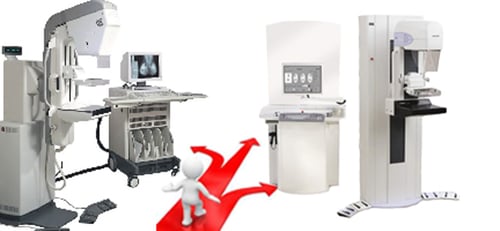When we get requests for digital mammography systems at Atlantis Worldwide, our customers generally ask for Hologic (Selenia or Selenia Dimensions) or GE (Senographe 2000D, Senographe DS or Essential). We find that many of our customers have the same questions, goals and concerns, so we’ve created this list of pros and cons that can help YOU better understand your options and needs. Of course, we’re always here if you want to talk, too!
 Let’s start with the basics: digital mammography is an imaging procedure that uses low-dose x-rays to examine breasts and aid in the detection and diagnosis of breast diseases in women. The technology converts x-rays to electrical images that can be viewed and stored on a computer. Hologic and GE are manufacturers of commercially available digital mammography detectors.
Let’s start with the basics: digital mammography is an imaging procedure that uses low-dose x-rays to examine breasts and aid in the detection and diagnosis of breast diseases in women. The technology converts x-rays to electrical images that can be viewed and stored on a computer. Hologic and GE are manufacturers of commercially available digital mammography detectors.
Conversion Methods
Digital mammography systems can be divided into two classes: direct and indirect conversions.
The Hologic digital mammography system uses direct conversion, which converts x-rays to electric charges in one step. (So does Siemens) It uses a flat-panel amorphouse selenium (a-Se) array.
Advantages:
• The detector response function maintains its sharpness even with increasing thickness
• You can achieve high MTF and DQE
Disadvantages:
• High biasing voltage is needed
• The dark signal drifts
• The cost of the detector is higher
• The inherent sharpness of the detector may increase the severity of aliasing artifacts associated with under sampling on any digital detector
The GE system uses indirect conversion of imaging X-rays. It uses a single flat-panel scintillator and an amorphous silicon (a-Si) diode array
A scintillator absorbs the X-rays and generates light scintillation that is detected by an array of photodiodes. This results in resolution degradation and poor quantum efficiency.
Advantages:
• Close bonding between CsI and a-Si ensures minimal light loss
• The strong signal from the Si diode array yields higher detective quantum efficiency
• The detector is linear over a wide range (105) of exposures
• Smaller pixel sizes improve spatial resolutions
Disadvantages:
• Smaller pixel sizes means increased image noise and decreased SNR for the same breast dose
• Ghosting can occur in images
Field of View
The field of view provided by a mammography system should be large enough to accommodate the breast size of most women. In order to be able to image most of the adult female population, the imaging field of view must be similar to the size of the largest screen-film cassette commonly used in screen film imaging, 24 x 30 cm. Detectors that are the size of the smaller cassette, 18 x 24 cm, will require imaging and tiling of many images to cover the breast field of view for larger breasts. For the U.S. demographics, up to 30 percent of all women require the larger field of view.
• According to Hologic, digital detectors measuring 18 by 24 cm are too small to image approximately 20 to 30 percent of U.S. women. Hologic's system detector measures 24 by 29 cm.
• As of 2011, GE manufactured one system with a detector measuring 18 by 23 cm and a second system with one measuring 24 by 31 cm.
Pixel Size
Images created using digital mammography are made up of tiny dots of light called pixels. Small pixels generally produce clearer, more defined images than large pixels. According to the Radiological Association of North America, mammography requires pixel sizes ranging from 50 to 100 microns per pixel.
• GE pixel sizes measure 100 microns. Light blurring in indirect conversion systems like GE interferes with the effective design and performance of systems with very fine resolution.
• Hologic pixel sizes measure 70 microns. Direct conversion systems like Hologic, in contradiction, can have their resolution characteristics optimized independently from their quantum detection efficiency and can be designed with an optimum pixel size.
Hopefully this summary has helped demystify the difference between direct and indirect conversion systems. While each offers advantages and disadvantages, as always, you can experience great savings by purchasing a refurbished system from Atlantis Worldwide. You’ll get the benefits of our expertise, like-new warranties and stress-free maintenance programs.
Please call 800-533-3356 or 212-366-9100 for a quote or more information on Mammography Systems. Contact US!





